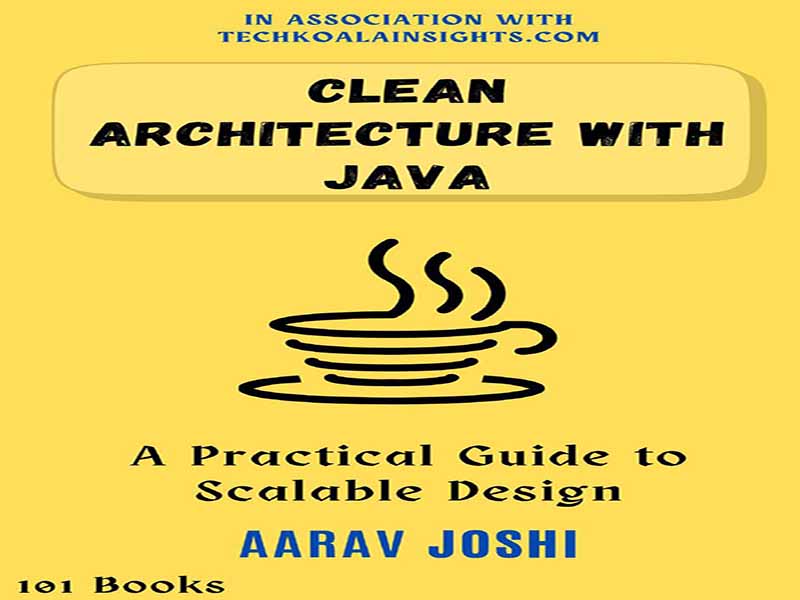- عنوان کتاب: Clean Architecture with Java A Practical Guide to Scalable Design
- نویسنده: Joshi, Aarav
- حوزه: برنامه نویسی جاوا
- سال انتشار: 2024
- تعداد صفحه: 576
- زبان اصلی: انگلیسی
- نوع فایل: pdf
- حجم فایل: 4.37 مگابایت
معماری پاک یک رویکرد اساسی در طراحی نرمافزار است که به چالشهای رایج تیمهای توسعه در هنگام ساخت و نگهداری سیستمهای پیچیده میپردازد. با افزایش اندازه و پیچیدگی پروژههای نرمافزاری، نیاز به یک رویکرد ساختاریافته و سازمانیافته به طور فزایندهای آشکار میشود. این بخش به بررسی دلایل غیرقابل مدیریت شدن پایگاههای کد میپردازد، بر اهمیت یک ساختار تعریفشده تأکید میکند و تأثیر معماری پاک بر همکاری تیمی را مورد بحث قرار میدهد. پروژههای نرمافزاری اغلب با نیتهای خوب و چشماندازی روشن شروع میشوند. با این حال، با اضافه شدن ویژگیها، تغییر الزامات و نزدیک شدن به مهلتها، ساختار اولیه میتواند به سرعت رو به زوال برود. این زوال منجر به چیزی میشود که معمولاً به عنوان “بدهی فنی” شناخته میشود، جایی که میانبرها و رفع سریع با گذشت زمان انباشته میشوند و نگهداری و گسترش پایگاه کد را به طور فزایندهای دشوار میکنند. یکی از دلایل اصلی پایگاههای کد غیرقابل مدیریت، عدم وجود مرزهای مشخص بین اجزای مختلف سیستم است. هنگامی که مسئولیتها به خوبی تعریف نشده باشند، توسعهدهندگان ممکن است سهواً اتصال محکمی بین ماژولهایی که باید مستقل باشند ایجاد کنند. این اتصال، اصلاح یک بخش از سیستم بدون تأثیر بر سایر بخشها را چالشبرانگیز میکند و منجر به یک پایگاه کد شکننده میشود که در آن تغییرات در یک منطقه میتواند باعث مشکلات غیرمنتظره در جای دیگر شود. یکی دیگر از مشکلات رایج، فقدان یک الگوی معماری منسجم است. بدون یک چارچوب راهنما، بخشهای مختلف سیستم ممکن است با استفاده از رویکردهای مختلف پیادهسازی شوند که منجر به مجموعهای درهم و برهم از سبکها و الگوها میشود. این ناهماهنگی، درک سیستم را برای اعضای جدید تیم دشوار میکند و احتمال ایجاد اشکالات هنگام ایجاد تغییرات را افزایش میدهد. اهمیت ساختار در طراحی نرمافزار را نمیتوان نادیده گرفت. یک پایگاه کد خوب ساختار یافته، مزایای بیشماری از جمله بهبود قابلیت نگهداری، مقیاسپذیری و قابلیت آزمایش را فراهم میکند. هنگامی که اجزا مسئولیتها و رابطهای واضحی دارند، درک نحوه تعامل بخشهای مختلف سیستم آسانتر میشود. این وضوح به توسعهدهندگان اجازه میدهد تا با اطمینان خاطر تغییرات را انجام دهند و بدانند که ناخواسته بخشهای دیگر برنامه را مختل نمیکنند. معماری تمیز، جداسازی دغدغهها را ترویج میدهد، اصلی که از تقسیم یک برنامه کامپیوتری به بخشهای مجزا حمایت میکند و هر کدام به یک دغدغه جداگانه میپردازند. معماری تمیز با سازماندهی کد به لایههایی با مسئولیتهای تعریفشده، به مدیریت پیچیدگی کمک میکند و استدلال در مورد سیستم به عنوان یک کل را آسانتر میکند.
Clean architecture is a fundamental approach to software design that addresses the common challenges faced by development teams as they build and maintain complex systems. As software projects grow in size and complexity, the need for a structured and organized approach becomes increasingly apparent. This section explores the reasons why codebases become unmanageable, emphasizes the importance of a well-defined structure, and discusses the impact of clean architecture on team collaboration. Software projects often start with good intentions and a clear vision. However, as features are added, requirements change, and deadlines loom, the initial structure can quickly deteriorate. This deterioration leads to what is commonly known as “technical debt,” where shortcuts and quick fixes accumulate over time, making the codebase increasingly difficult to maintain and extend. One of the primary reasons for unmanageable codebases is the lack of clear boundaries between different components of the system. When responsibilities are not well-defined, developers may inadvertently create tight coupling between modules that should be independent. This coupling makes it challenging to modify one part of the system without affecting others, leading to a fragile codebase where changes in one area can cause unexpected issues elsewhere. Another common issue is the absence of a consistent architectural pattern. Without a guiding framework, different parts of the system may be implemented using various approaches, resulting in a hodgepodge of styles and patterns. This inconsistency makes it difficult for new team members to understand the system and increases the likelihood of introducing bugs when making changes. The importance of structure in software design cannot be overstated. A well-structured codebase provides numerous benefits, including improved maintainability, scalability, and testability. When components have clear responsibilities and interfaces, it becomes easier to understand how different parts of the system interact. This clarity allows developers to make changes with confidence, knowing that they are not inadvertently breaking other parts of the application. Clean architecture promotes the separation of concerns, a principle that advocates dividing a computer program into distinct sections, each addressing a separate concern. By organizing code into layers with welldefined responsibilities, clean architecture helps manage complexity and makes it easier to reason about the system as a whole.
این کتاب را میتوانید از لینک زیر بصورت رایگان دانلود کنید:
Download: Clean Architecture with Java




































نظرات کاربران